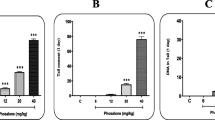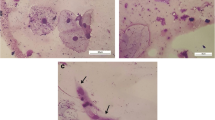Abstract
The feeding of lactating goats on usual green fodder, contaminated with Euphorbia helioscopia or E. nubica, results in poisoning of the dams as well as their suckling kids. General signs of toxicity were emaciation, depression, shedding of body hair, arching of back, and possible death. Post-mortem changes of dams and dead suckling kids included congestion and hemorrhage in cardiac muscle, lung, liver, and kidneys. Blood analyses of goats exposed to these contaminants showed an increased level of serum alanine amino transferase compared to control samples, indicating cellular destruction in the liver. The latter was confirmed by histopathological changes in the organ which include severe congestion, necrosis, and degenerative changes. The goats also suffered from deterioration of renal function as indicated by increased blood urea nitrogen and creatinine levels. In histopathologic inspections of kidney, severe congestion, hemorrhage in the cortex and medulla, as well as necrosis of epithelial cells of kidney tubules were noticed. Considerable degenerative changes were also observed in heart and lung. The pathophysiological appearances indicate that by feeding on the Euphorbia species mentioned above, the goats are poisoned in a way similar to the case of E. peplus reported previously. Such intoxication most likely is due to irritant and hyperplasiogenic diterpene ester (DTE) toxins, usually present in the aerial parts of Euphorbia species and well known as tumor promoters in mouse skin. After ingestion of the toxic plant parts by the goats, the DTE toxins might be metabolized and thereby partially detoxified. Yet, at least in part, they may show up in the milk of the goats, as indicated by severe poisoning of their suckling kids. As discussed previously in lactating goats fed on fodder contaminated with E. peplus, tumor promoters of the DTE type may enter the human food chain via this source of milk. Such milk may be considered a valuable etiologic model for the investigation of economic, ecologic, and public health problems raised by human diet polluted with tumor promoters, i.e., conditional (non-genotoxic) cancerogens.
Similar content being viewed by others
Author information
Authors and Affiliations
Additional information
Received: 25 July 2000 / Accepted: 18 September 2000
Rights and permissions
About this article
Cite this article
Nawito, M., Ahmed, Y., Shalaby, S. et al. Dietary cancer risk from conditional cancerogens (tumor promoters) in produce of livestock fed on species of spurge (Euphorbiaceae) . J Cancer Res Clin Oncol 127, 34–39 (2001). https://doi.org/10.1007/s004320000213
Issue Date:
DOI: https://doi.org/10.1007/s004320000213




